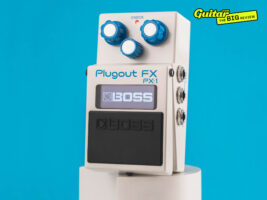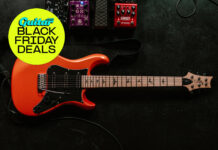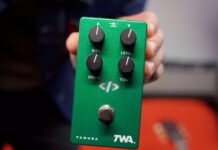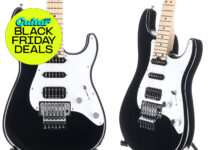
Boss PX-1 Plugout FX review – “This is a pedal that could find a home in a lot of rigs”
£199/$249, boss.info
Everyone loves Boss pedals, don’t they? But over the last 50 years, the Japanese pedal giant has produced an almost countless number of funny little boxes, and many of them are now discontinued, and either hard to find, prohibitively expensive, or both.
READ MORE: Crazy Tube Circuits Venus review – ”Crazy Tube Circuits may well have created a masterpiece”
Enter then, the Boss PX-1 Plugout FX – a brand new and very Boss-y take on the concept of a multi-effects unit that promises to act as an archive of some of the most iconic, missed and hard to find compact pedals the brand has ever made.
It’s also a pedal that has provoked more online opprobrium than any other Boss product in the company’s long history… so what gives? Well…
Image: Adam Gasson
Boss PX-1 Plugout FX – what is it?
Well, the clue is very much in the name. For the last year or so, through its Roland Cloud service, Boss has been making plugin versions of its most iconic effects for use in the box with your preferred DAW or software guitar amp and effects platform. The Plugout takes a bunch of these plugins and quite literally lets them out of the box, and enables their use as part of any normal effects chain. Plugin > Plugout… geddit?
The plugins offered at launch run the gamut of the stone cold classics – such as the DS-1, SD-1 and CS-1 – and out-of-production gems like the CE-2, OD-1, OC-2, VB-2 and DD-2. Then there’s the ‘weird shit’ – hard to find curios from the Boss annals like the SG-1 Slow Gear and DF-2 Super Feedbacker & Distortion and the SP-1 Spectrum Equalizer.
You get 16 plugins included at launch, but that won’t be the case for long. Boss is planning to add many more plugins to the selection, starting with the OD-2, DM-2 and DC-2 in January 2026. There is a catch, however – only those first 16 are ‘free’. While you can audition any of the new effects gratis (every 30 seconds the audio will drop briefly in this demo mode), they’ll cost $9.99 each to download and keep forever.
Now, this facet is by SOME DISTANCE the main thing that people – particularly the sort of guitar YouTubers who seem to be permanently outraged – have really zeroed in on. I think there’s some valid discussion to be had about all this, but I think it’s best covered at the end of this review.
One thing that should be made clear however is that you do NOT need to have a subscription to run this pedal – as some have erroneously suggested. After you’ve created the free Roland account, those 16 models are yours to load onto the pedal forever, and once they’re on there, they’re on there. Creating the account gives you a lifetime license to use the plugins on your PX-1, even if you don’t ‘own’ it in the most traditional sense – given that we all merrily click ‘accept’ on much more restrictive software licenses every day, I don’t know if it’s really worth getting that worked up about.
Image: Adam Gasson
Boss PX-1 Plugout FX – build quality and usability
If the two things most likely to survive a nuclear apocalypse are Keith Richards and cockroaches, then you can probably slot the venerable Boss Compact Pedal in as a respectable third. There’s a reason the design has barely changed in nearly 50 years – it’s simple, functional and absolutely bomb-proof. And the best compliment I can give the PX-1 is that despite its clearly very high-tech innards, in hand this feels just as reliable and reassuring and familiar as any other Boss pedal I’ve picked up in the last few decades.
There are differences of course – lord knows my DS-1 never had a USB-C port or a MIDI clock input – but they’re all discrete and don’t detract from the inherent functionality of the thing. Even the new screen above the footswitch feels suitably rugged – I reckon you could drop a fair few heavy things on this screen and it wouldn’t bat an eyelid. Pretty sure the good folks at Boss wouldn’t appreciate me testing this out with my review loaner, and I’d avoid trying it at home, too. Still, it feels reassuring!
If you’re anything like me, the words ‘companion app’ in relation to any guitar product is enough to send a chill down your spine. When they work, they can create a truly enhanced and seamless experience. When they don’t, it can ruin the whole damn thing – especially if some boffin has decided that huge amounts of functionality is hidden inside.
You can load 16 effects onto the PX-1 – eight permanently installed “1” models that come pre-loaded, but if you want to add the further eight effects that are available for free at launch, you’ll have to download the app and sign up for a Roland account. This is how they get you, friends.
Begrudgingly, then, I download Boss’s Effect Loader app onto my iPhone and begin the process of pairing it with the PX-1. My hackles were at half mast at this point, because the process is not exactly intuitive out the gate – reaching for the manual before you’ve even plugged in is often not a good sign. But there’s actually a quite sensible reason for this.
Image: Adam Gasson
Unlike most modern Bluetooth products, the PX-1 doesn’t have it on all the time, you have to navigate through the menu using the three clickable knobs on the pedal to turn it on, and then connect via the app.
Once you’ve done this, it takes a few seconds to connect and then you’re presented with a screen of your available pedals – tap on said pedal, and you get the option to send it to the PX-1. A progress bar appears on both the pedal and the app, and about 90 seconds later you’re good to go. You’ll stay connected to the app until you start fiddling with the pedal itself, at which point you’ll be prompted to disconnect.
This ‘not always on’ approach is a little unusual for sure, but it kinda makes sense – why would you want something emitting a wireless signal on your perfectly crafted and isolated pedalboard unless you needed it? And the good news is that after you’ve loaded on your effects of choice, you don’t. Unless you wish to upload a different pedal to one of the user slots, you need never think about the Effect Loader app again if you so wish – and that’s the sort of companion app I can get behind.
You can also use the app to download the latest firmware for the pedal, though you can’t do that via Bluetooth. Again, the process is a little unwieldy – but effective! First you have to connect your phone to the pedal via a suitable cable, and then you have to restart the pedal while holding down the footswitch to enter update mode. If this all is starting to sound a bit too much like the sort of thing that made me stop using PCs, I’m right there with you – but don’t fret. Yes, the update process is a bit fiddly and weird – but it works. Quickly, efficiently, and consistently – I will take that all day long over less Heath Robinson methods that don’t.
With the pedal set up and updated, we wave goodbye to the app and hook it up – you have stereo in and outs here, but handily it’s all powered by a standard 9V DC barrel jack. Boss forever insists that you should only use its PSU (which is included) but realistically, nobody’s paid any attention to that since about 2001.
That expression pedal control widens the usability too – either you can set it up with a footswitch and use it to swap between two effects on the fly, or you can hook it up to an expression pedal and use that to control the sweep of any of the controls on your selected effect. You couldn’t do that with my DS-1 either.
Image: Adam Gasson
Boss PX-1 Plugout FX – sounds
I shan’t waste your time talking too much about the DS-1 and SD-1 – anyone who has ever been in a guitar shop knows exactly what these two most ubiquitous Boss dirt pedals sound like, and the PX-1 does an exceptionally faithful job of recreating them. My question is why do they even need to be part of the preinstalled launch lineup in the first place? Nobody is spending $250 to get the authentic sound of a $70 pedal are they?
At the other end of the rareness scale, Boss pedal tragics will have noticed that among the stompboxes included in the PX-1 are the first three Boss compacts ever made 48-ish years ago – the OD-1, SP-1 and PH-1. That seems like as sensible a place as any to really kick things off, and what a lovely place to begin the OD-1 is. It’s thick, meaty and ragged in the best kind of way, and has real punch and bite when you add some swarthy humbuckers to the mix.
The SP-1 is er… well it’s a single-band parametric EQ, and while it does a nice job of cleaning up muddier sounds, I wouldn’t call its inclusion here a deal-maker despite it being one of the rarest early Boss pedals out there. The PH-1 is a much more enjoyable affair, offering a quite polite and classic phaser sound with plenty of low-end depth without ever getting too wiggy.
The CS-1 compressor really is a reminder of how punchy those early pedal compressors were – this isn’t a modern transparent effect but a powerful vice-like clamp on your signal that adds punch and panache but only in the right environment. It’s a sound that, ironically, would pair sublimely with the majesty of the CE-2 – it’s lush and deep and sumptuous in the way that classic 80s Boss chorus pedals always have been.
Image: Adam Gasson
The Slow Gear is one of those pedals that has become part of guitar folklore, because it’s both extremely rare and pretty unique. Unlike, say, the SP-1, having the chance to spend some time with it here makes you realise why it’s so sought after. The volume swell effect sounds great and is very unique – exactly the sort of thing the PX-1 should have more of.
The OC-2 remains a marvel of accurate octave tracking given its age, while the warm wobble of the VB-2 is as compelling now as it ever was.
The surprise favourite for me was the PS-2 Digital Pitch Shifter/Delay – with eight-bit processing and a truly mad blend of delay and pitch shifting, it’s a very quick route to surprising Jack White wig-outs.
The DF-2 is another pedal that really rams home the fun part of the PX-1 – the tactile sense of actually experiencing these pedals in their original compact pedal form. Holding down on the footswitch to force your notes to bloom into wonderfully controlled feedback would be much less interesting in a pedal that wasn’t shaped exactly like a Boss compact.
Time and again, the prevailing sense is not just that these pedals sound really good – as good as the originals to my ears – but that the experience of using them is authentic, too, and that might be the true killer app of the PX-1.
Image: Adam Gasson
Boss PX-1 Plugout FX – should I buy one?
Okay, let’s get into it. If we’re comparing compact multi-effects units, the PX-1 is under-gunned compared to some of its competition. For $50 more, the Line 6 HX One unquestionably does a much more comprehensive job, with hundreds of onboard effects straight out of the box. And look, if that’s what you want, I cannot stress enough that you should buy the HX One.
The existence of the Plugout FX doesn’t stop anyone from doing that, and I would imagine the folks at Boss would similarly suggest that they already make plenty of multi-effects units – the purpose of the PX-1 is very different.
Because if all any of us wanted was the maximum amount of sounds in the smallest possible footprint, individual stompboxes would have gone the way of the buffalo about 30 years ago, and multi-effects would be the only flavour of floor-based soundscaping we could buy.
But guitarists are weird. Many of us don’t want all that – for some, option paralysis is the very enemy of creativity. For them, the stripped back simplicity and WYSIWYG usability of the PX-1 is the closest they’ll ever come to wanting a multi-effects on their board.
The thornier issue is one of the extra costs. Some will say that when you’ve spent $250 on a pedal, you shouldn’t then be asked to fork out all over again for added extras. I don’t think people are wrong for feeling that way, especially because of the precedent that it potentially sets – do we really want to live in a world where the microtransactional hellscape of modern gaming is transported over to our pedalboards?
But Boss is at pains to point out that these extra effects aren’t sitting on the PX-1 waiting to be unlocked – you’ll have to physically download the algorithm from the cloud to use it. In that regard it’s probably sensible to think of it less like a microtransaction and more like DLC – you’re paying to get something substantial, not the guitar equivalent of horse armour.
For some, this is still a step too far, and I get it – I do. But I would also remind people that Boss hasn’t pulled this idea out of nowhere. Who remembers the DigiTech iStomp? You probably don’t, because for all the ‘potential game-changer’ chat when it launched in 2012, it never really caught on, in no small part because guitarists did not want to pay for virtual pedals that they could load onto a stompbox one at a time.
There’s also more modern takes on the ‘plugins but in a pedal’ concept like the Chaos Audio Stratus or the MOD Dwarf – they’ve found their own dedicated communities without the guitar world slipping off its axis, and I imagine it’ll be a similar situation for the PX-1.
Because ultimately, without wishing to sound like a turbo-capitalist, the market will decide if this is a good idea or not. If people buy the pedal and keep buying plugins for it, Boss will likely keep adding new pedals, and expanding the PX family to support that. If they don’t, well at least you’ll always have those 16 launch pedals.
For those complaining that there are only 16 pedals included in this thing, however, I would point you to Reverb to have a look at how much say, an original Slow Gear or SP-1 will set you back. The PX-1 is a way to experience these pedals, even the weirdos, in a way that is much more accessible and affordable.
But this isn’t to say that the launch Plugout FX is without its shortcomings. I understand why Boss wanted to make the launch proposition of the initial 16 effects cover a broad gamut of classics, rarities and staples… but the lack of any reverb is very frustrating – my kingdom for an RV-3! There’s also the question of where it goes in your rig. This is the issue with a lot of these jack-of-all-trades stompboxes, but it feels even more so with the PX-1. Without hooking it up to an effects switcher, you’re forced into compromises in terms of signal chain. After all, you’re unlikely to want your OD-1 in the same place in the chain as your DD-2, are you?
That for me would be a bigger deal-breaker than any of the angry shouting online – and one that is ultimately exacerbated by the small selection of effects on offer at launch. But if you can accept that there will be compromises in that regard, the Plugout FX really does seem like a pedal that could find a home in a lot of rigs. Putting aside the online noise and taking it on its own merits, the PX-1 is a fun pedal with bags of potential to be a living repository of the rarest, weirdest and most interesting Boss pedals of the last five decades. Everyone should have at least one Boss pedal on their pedalboard, and this might be it.
Boss PX-1 Plugout FX – alternatives
The biggest direct competitor for the PX-1 probably comes in the shape of TC Electronic’s Plethora X1 ($151/£129). It offers 14 different effects types in one compact box, but unlike the PX-1 you can use two at the same time. The elephant in the room here is, of course, Line 6’s HX One ($299/£219) – which offers 250 Helix-level high-end sounds in one box. If you want lots of sounds in one pedal, that is very much the option du jour. The king of the high-end mini-multis is probably Eventide’s H9 Max ($599/£529) – it’s not cheap, but with over 50 of Eventide’s best and brightest on board, it’s hard to beat in terms of pure sound quality.
The post Boss PX-1 Plugout FX review – “This is a pedal that could find a home in a lot of rigs” appeared first on Guitar.com | All Things Guitar.
Source: www.guitar-bass.net













